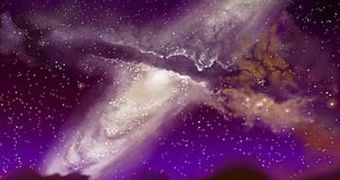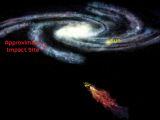So I was watching the news bulletin the other day and I heard some of the most outrageous news ever! They were saying something like: 'A giant black hole will swallow the whole Milky Way!' I calmly turned off the TV-set and went to work, searching the Internet for information regarding the elusive black hole, but failed to find any. I was thinking to myself, 'Wow, that TV station must have some really good astrophysicists working for them!'
Well, as it turned out, the news was greatly distorted, so don't worry, our galaxy won't be eaten by a monstrous black hole. At least not now, maybe in the very distant future. However, we got the next best thing, as it seems that, in a very short period of time, the Milky Way will collide with a massive cloud of gas.
Short period meaning somewhere between 20 to 40 million years. The cloud, named Smith's Cloud, discovered in 1963, located in what we call the Local Group, about 8,000 light-years away from the Milky Way's galactic disk, is about 2,500 light-years wide and 11,000 light-years long. To put it in simpler terms, if this large cloud of matter would be visible from the surface of the planet with the naked eye, it would appear on the night sky as an object about 30 times the width of the apparent size of the Moon.
Ever since its discovery, astronomers had difficulties in determining the motion of this cloud. Meaning they could not precisely measure if the cloud was moving towards or away from us, if it belonged to the Milky Way or it is a remnant from the formation of our galaxy. New radio observations of the massive cloud of gas, made with the National Radio Astronomy Observatory in Green Bank, revealed that it is most likely formed entirely of gas, and presents no evidence of a star formation process, or any star for that matter.
The massive gas cloud located in the direction of the Orion constellation, visible only in the radio wavelengths of the electromagnetic spectrum, seems to be moving in the general direction of the Milky Way at speeds of about 870,000 kilometers per hour, and is expected to collide with our galaxy somewhere in 20 to 40 million years. It is possible that the gravitational interactions with our galaxy would rip the gas cloud apart.
However, the most likely scenario is that, as the cloud of gas collides with our galaxy, it would increase the concentrations of gas, which may trigger a rapid star formation process, creating massive stars, burning hydrogen fuel at extremely high rates, that would explode into supernovae after their short lives, spreading new heavy elements into interstellar space, essential for solar system formation.

 14 DAY TRIAL //
14 DAY TRIAL // 
